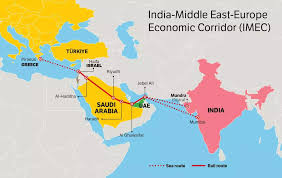India-Middle East–Europe Economic Corridor:

The India–Middle East–Europe Economic Corridor (IMEC), unveiled at the 2023 G20 Summit, aims to link India with Europe through the Middle East.
- However, ongoing conflicts in West Asia and emerging Arctic routes pose serious challenges to its implementation and strategic viability.
- IMEC is a strategic multi-modal connectivity initiative launched through a MoU at the G20 Summit 2023, New Delhi. It has two corridor segments Eastern Corridor (connects India to the Gulf region) and Northern Corridor (connects the Gulf region to Europe).
- IMEC signatories include India, US, Saudi Arabia, UAE, France, Germany, Italy, and the EU. It is part of the G7’s Partnership for Global Infrastructure and Investment (PGII, 2021).
- The IMEC emerged in 2023 amid favourable geopolitics, supported by the Abraham Accords and improving India-UAE, Saudi Arabia, and US ties. It aims to link Israel’s Haifa port with Jordanian railways and Gulf ports.
- IMEC aims to develop an integrated network of ports, railways, roads, sea lines, energy pipelines, and digital infrastructure (undersea digital cables) to enhance trade and economic cooperation between India, the Middle East, and Europe.
- IMEC is designed as a transparent, sustainable, and debt-free alternative to China’s Belt and Road Initiative (BRI), ensuring infrastructure development without compromising national sovereignty.
- Economic & Strategic Benefits for India: IMEC reduces logistics costs by ~30% and transport time by ~40% versus the Suez Canal route, boosting export competitiveness.
- For India, IMEC is a strategic opportunity to diversify trade routes, reducing reliance on chokepoints like the Suez Canal. The corridor enhances access to European markets via the Mediterranean, providing an alternative to China’s BRI.
- With the EU as one of India’s largest trading partners (USD 136 billion in 2024-25), stronger connectivity could boost export competitiveness.
- IMEC also aligns with India’s Act West policy, deepening engagement with the Middle East for energy security, remittances, and diaspora links, while countering Pakistan’s regional strategic influence.
- It aligns with India’s One Sun One World One Grid (OSOWOG) initiative to harness solar and green hydrogen energy from the Middle East and supports India’s transition to a low-carbon economy.




